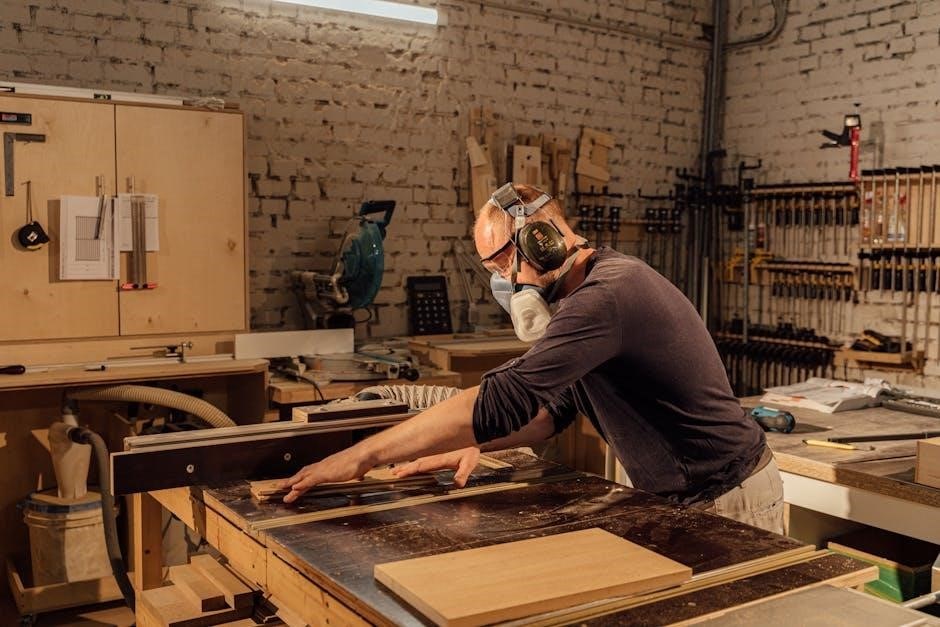Table saw station plans in PDF format offer comprehensive guides for woodworkers. These plans detail constructing a functional and safe workspace. The convenience of PDF allows easy access. They often include step-by-step instructions and clear diagrams for building.

Benefits of Using Table Saw Station Plans
Table saw station plans offer numerous benefits for woodworking enthusiasts. These plans provide a structured approach to building a dedicated workspace. They ensure accuracy and safety. The result is improved efficiency and customized solutions for individual workshop needs.
Improved Accuracy and Safety
Using table saw station plans significantly improves accuracy and safety in woodworking projects. These plans provide precise measurements and construction techniques that minimize errors. A stable and well-designed station reduces the risk of accidents. It also offers better control over the material being cut. This results in cleaner‚ more accurate cuts. Adhering to the plan’s safety guidelines ensures a safer working environment for all woodworking tasks.
Enhanced Workshop Efficiency
Implementing table saw station plans noticeably enhances workshop efficiency. A well-organized station keeps essential tools and materials within easy reach. This reduces time wasted searching for equipment. The structured design streamlines workflow‚ allowing for smoother transitions between tasks. Integrated features like dust collection further contribute to a cleaner and more productive workspace. A thoughtfully planned station optimizes space and minimizes clutter‚ leading to more efficient woodworking.
Customization Options
Table saw station plans offer extensive customization options. Woodworkers can modify the plans to fit their specific needs and preferences. Adjustments can be made to dimensions‚ storage solutions‚ and added features. Integrating miter saw stations or specialized drawers enhances functionality. The ability to tailor the station ensures it perfectly complements existing tools and workflow. These adaptations create a personalized workspace optimized for individual projects and shop layouts‚ improving overall utility.
Key Features to Look for in Table Saw Station Plans
When choosing table saw station plans‚ prioritize key features. Look for mobility‚ storage‚ and efficient dust collection integration. Outfeed support is also crucial for handling larger workpieces. These features enhance functionality and safety.
Mobility and Storage
Mobility and storage are essential for table saw stations. Casters allow easy movement around the shop‚ optimizing space. Integrated storage‚ such as drawers and shelves‚ keeps tools and accessories organized. These features improve workflow and efficiency. Consider locking casters for stability during use. Ample storage reduces clutter and maximizes workspace. A well-designed station combines both for convenience.
Dust Collection Integration
Dust collection integration is vital for a clean and safe workshop. Table saw stations can incorporate ports for connecting to dust collection systems. This reduces airborne particles and improves air quality. Efficient dust removal enhances visibility and minimizes health risks. Consider designs that capture dust at the source. Integrating dust collection creates a healthier and more pleasant woodworking environment.
Outfeed Support
Outfeed support is crucial for handling large workpieces safely. Table saw stations should include adequate outfeed support to prevent material from tipping. This support can be fixed or adjustable‚ catering to different project sizes. Proper outfeed support ensures smooth and accurate cuts. It reduces the risk of kickback and improves overall control. Consider incorporating rollers or extension tables for enhanced support.

Essential Materials and Tools
Constructing a table saw station requires specific materials and tools. Lumber‚ fasteners‚ and hardware are essential. Power tools like saws and drills are necessary. Measuring devices ensure accuracy. Quality components contribute to a durable build.
Lumber Selection
Choosing the right lumber is crucial for a sturdy table saw station. Consider factors like wood type‚ thickness‚ and straightness. Softwoods like pine are affordable. Hardwoods such as oak offer greater durability. Plywood provides a stable and flat surface for the tabletop. Ensure the lumber is free from knots. Warping affects the station’s integrity. Select appropriate sizes to minimize waste. Proper lumber selection ensures long-lasting performance.
Fasteners and Hardware
Selecting appropriate fasteners and hardware is essential for a robust table saw station. Screws‚ bolts‚ and nails securely join lumber components. Choose screws with sufficient length and strength. Washers prevent screws from pulling through the wood. Heavy-duty bolts provide added stability for critical joints. Casters enable mobility‚ so opt for durable‚ load-bearing models. Hinges facilitate folding or pivoting features. Drawer slides allow smooth operation of storage. Quality hardware ensures the station’s longevity and functionality.
Power Tools and Measuring Devices
Accurate construction relies heavily on reliable power tools and measuring devices. A table saw is essential for precise cuts. A drill or impact driver assembles components efficiently. A measuring tape and combination square ensure accurate dimensions. A level guarantees a flat and stable surface. A random orbital sander smooths surfaces. Clamps hold pieces securely during glue-up. Consider a router for edge profiling or joinery. Safety glasses and hearing protection are crucial. Proper tools ensure precision‚ safety‚ and a professional finish.
Step-by-Step Construction Overview
Building a table saw station involves several stages. It starts with cutting the lumber. Next is assembling the frame. After that comes tabletop construction. Then mobility is added with casters. Finally‚ dust collection is integrated for safety.
Framing and Base Assembly
The initial stage of construction focuses on creating a sturdy frame and base. This involves cutting lumber according to the plan’s dimensions and assembling it using screws or other fasteners. It’s crucial to ensure the frame is square and level. A solid base provides stability. This stability is important for the entire table saw station. Pay close attention to the plans for specific joinery techniques. Proper assembly is vital for safety and longevity.
Tabletop Construction and Attachment
The tabletop is a crucial component‚ often constructed from plywood or MDF. Cut the material to the specified dimensions. Reinforce it with additional framing for added support. Ensure a flat and level surface. Attaching the tabletop securely to the base is essential. Use screws and construction adhesive for a strong bond. Precisely align the tabletop with the frame. Misalignment can affect the table saw’s performance and accuracy. The tabletop should be robust enough.
Adding Mobility with Casters
Incorporating casters enhances the table saw station’s portability. Choose heavy-duty casters with a high weight capacity. Swivel casters provide maximum maneuverability in the shop. Consider locking casters to secure the station in place during use. Attach casters to the base frame using bolts and nuts. Ensure the casters are evenly spaced for stability. Reinforce the attachment points with backing plates for added strength. This allows easy relocation of the station. This feature is useful for small workshops.

Integrating Dust Collection
Effective dust collection is vital for a safe and clean woodworking environment. Integrating a system into your table saw station minimizes airborne particles. This improves visibility and reduces health risks. Design the station to accommodate dust ports and hoses.
Designing for Efficient Dust Removal
To maximize dust removal‚ consider the airflow within your table saw station. Enclose the saw’s base to contain dust. Strategically place dust ports near the blade. Use sloped surfaces to guide debris toward collection points. Incorporate baffles to direct airflow and prevent dust from escaping. Ensure all connections are airtight to maintain suction. Proper design significantly improves dust collection effectiveness and promotes a cleaner workspace. This contributes to a healthier and safer environment during woodworking projects.
Connecting to a Dust Collection System
Connecting your table saw station to a dust collection system involves selecting the right fittings. Use flexible hoses to allow for movement. Ensure the hose diameter matches your system’s requirements. Employ blast gates to control airflow to different tools. Seal all connections with tape or clamps to prevent leaks. Consider using a cyclone separator to pre-filter larger particles. This prevents clogging in your dust collector. A well-connected system significantly reduces airborne dust‚ enhancing air quality and workshop safety.
Safety Considerations During Construction and Use
Prioritize safety when building and using table saw stations. Wear safety glasses and hearing protection. Use push sticks and feather boards. Never reach over the blade. Disconnect power before adjustments. Ensure proper dust collection to minimize hazards.
Importance of Personal Protective Equipment (PPE)
Personal Protective Equipment (PPE) is crucial when constructing and utilizing table saw stations. Safety glasses protect eyes from flying debris‚ preventing potential injuries. Hearing protection‚ like earplugs or earmuffs‚ minimizes noise exposure‚ safeguarding auditory health. Dust masks or respirators prevent inhalation of fine particles‚ reducing respiratory risks. Gloves provide a better grip and protect hands. Prioritizing PPE ensures a safer woodworking experience.
Safe Operation Practices
Safe operation practices are essential when using a table saw station. Always read the table saw and station manuals thoroughly before starting any project. Ensure the blade is sharp and properly aligned. Use push sticks or push blocks to keep hands away from the blade. Never reach over or behind the blade while it’s running. Keep the work area clean and free of obstructions. Disconnect the power before making any adjustments or changing blades.
Free vs. Paid Table Saw Station Plans
Table saw station plans are available in both free and paid formats. Free plans offer cost-effective solutions. Paid plans provide detailed instructions and enhanced features. Consider your skill level and project complexity when deciding.
Advantages of Free Plans
Free table saw station plans provide an accessible entry point for woodworkers. This is especially for those on a budget or beginners. These plans often cover basic designs. They allow users to build a functional station without initial investment. They can be found online. They also offer a chance to test your skills. Free plans can be a great starting point for customization.
Benefits of Investing in Paid Plans
Investing in paid table saw station plans offers significant benefits. This includes detailed instructions‚ professional designs‚ and optimized functionality. Paid plans often include advanced features like dust collection integration. They also have precise measurements. These plans are usually made to ensure accuracy and safety. They can save time and reduce material waste. The enhanced support and detailed guidance can make them worth the investment.

Examples of Popular Table Saw Station Plans (PDF)
Popular table saw station plans include mobile stations for saws like the DeWalt DW745. There are also ultimate DIY rolling workbenches. These plans offer versatility‚ mobility‚ and efficient use of space. These examples are favored for their practicality.
Mobile Table Saw Station for DeWalt DW745
This plan offers a compact and mobile solution for DeWalt DW745 users. It features a cut list and dimensions for constructing the top and bottom frames. The frames are made from 38x63mm timber‚ ensuring durability. Instructions and diagrams guide the assembly process. It includes attaching the saw securely and adding a convenient shelf. The mobility allows for easy relocation within the workshop. Designed for smaller spaces‚ this station optimizes efficiency and organization.
Ultimate DIY Rolling Workbench
The ultimate rolling workbench combines multiple functionalities into one unit. It features a large worktop surface‚ catering to diverse projects. A fold-away miter saw station maximizes space utilization. It also includes a dedicated table saw station. This design offers practical use‚ quality‚ and simplicity. It is perfect for those needing a sturdy and long-lasting workstation. The plans allow for material and tool substitutions based on individual needs; The rolling feature enhances mobility and flexibility in any workshop setting.
Customization Ideas for Table Saw Stations
Customizing table saw stations allows woodworkers to tailor their setup. Adding miter saw integration expands functionality. Incorporating storage drawers and shelves maximizes space. These enhancements optimize workflow and create a more efficient workspace. It enhances the overall utility.
Adding Miter Saw Integration
Integrating a miter saw into a table saw station enhances versatility for crosscuts and angled cuts. This integration often involves creating a shared workspace. It has a common fence system. This setup streamlines workflow‚ reducing the need to switch between tools. It is necessary to ensure proper alignment and secure mounting for accurate cuts. This maximizes the utility of available shop space and improves efficiency. This is a popular customization.
Incorporating Storage Drawers and Shelves
Adding storage drawers and shelves to a table saw station optimizes space and organization. Drawers are ideal for storing smaller items. Think measuring tools‚ blades‚ and hardware. Shelves can accommodate larger items‚ like jigs‚ accessories‚ and project materials. Proper planning ensures easy access. Consider weight capacity and drawer slide quality for longevity. Thoughtful storage integration enhances efficiency and maintains a tidy workspace. Secure storage prevents accidental damage. This allows a safer environment in your shop.
Constructing a functional and safe table saw station significantly improves woodworking capabilities. By utilizing detailed PDF plans‚ even novice woodworkers can achieve professional results. Prioritizing safety features and incorporating dust collection are essential. Customization allows tailoring the station to specific needs. A well-built station enhances accuracy‚ efficiency‚ and overall enjoyment of woodworking projects. Remember to always prioritize safety. Regular maintenance will ensure long-term performance. A dedicated‚ organized space promotes a more productive and safer workshop.

Leave a Reply
You must be logged in to post a comment.